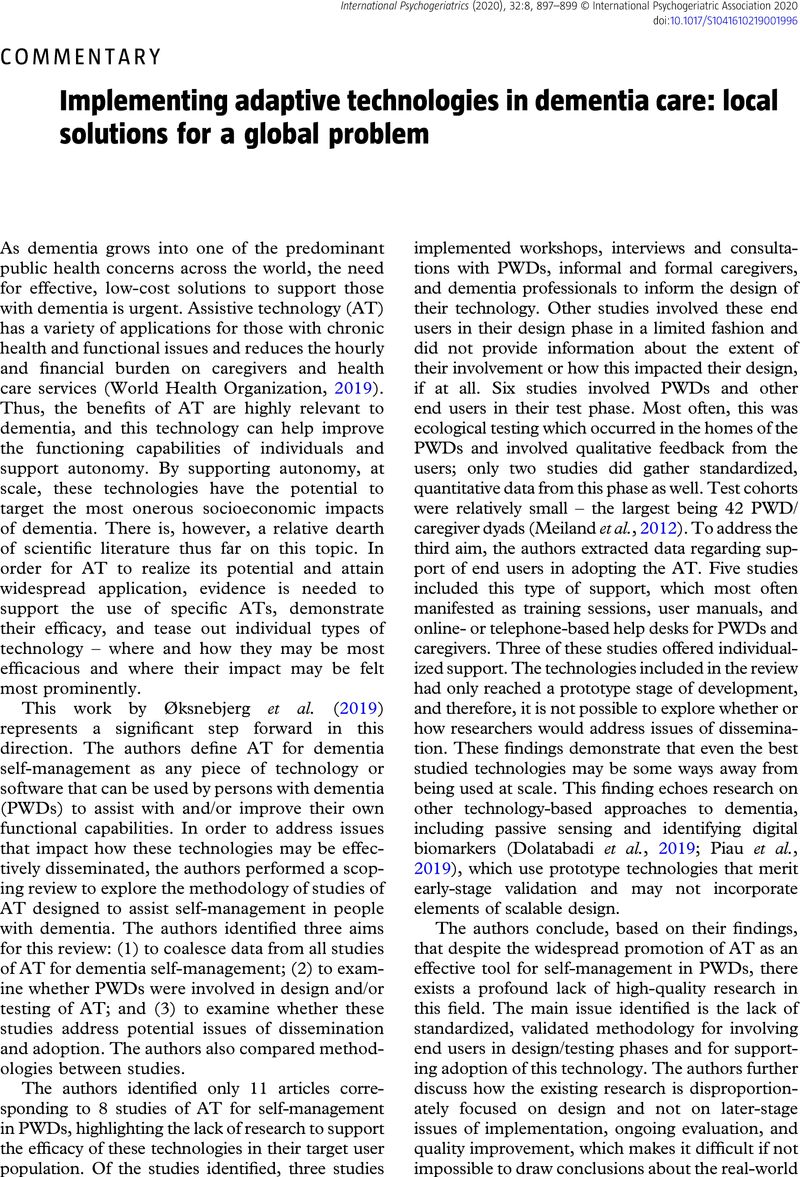No CrossRef data available.
Article contents
Implementing adaptive technologies in dementia care: local solutions for a global problem
Published online by Cambridge University Press: 16 September 2020
Abstract
An abstract is not available for this content so a preview has been provided. Please use the Get access link above for information on how to access this content.

- Type
- Commentary
- Information
- International Psychogeriatrics , Volume 32 , Issue 8: Issue Theme: Technology for Brain Health and Artificial Wisdom , August 2020 , pp. 897 - 899
- Copyright
- © International Psychogeriatric Association 2020
References
Alzheimer’s Association (2019). 2019 Alzheimer’s disease facts and figures. Alzheimer’s & Dementia, 15, 321–387. doi: 10.1016/j.jalz.2019.01.010.CrossRefGoogle Scholar
Beard, C., Silverman, L. A., Forgeard, M., Wilmer, M. T., Torous, J. and Björgvinsson, T. (2019). Smartphone, social media, and mental health app use in an acute transdiagnostic psychiatric sample. JMIR mHealth and uHealth, 7, e13364. doi: 10.2196/13364.Google Scholar
Collier, S., Monette, P., Hobbs, K., Tabasky, E., Forester, B. P. and Vahia, I. V. (2018). Mapping movement: applying motion measurement technologies to the psychiatric care of older adults. Current Psychiatry Reports, 20, 64. doi: 10.1007/s11920-018-0921-z.Google ScholarPubMed
Dolatabadi, E., Zhi, Y. X., Flint, A. J., Mansfield, A., Iaboni, A. and Taati, B. (2019). The feasibility of a vision-based sensor for longitudinal monitoring of mobility in older adults with dementia. Archives of Gerontology and Geriatrics, 82, 200–206. doi: 10.1016/j.archger.2019.02.004.Google ScholarPubMed
Hawkes, E., Heintz, H. and Vahia, I. V. (2019). Digitally enhanced art therapy and mindfulness in older adults. The American Journal of Geriatric Psychiatry. doi: 10.1016/j.jagp.2019.10.002.Google ScholarPubMed
Meiland, F.J.M.et al. (2012). Usability of a new electronic assistive device for community-dwelling persons with mild dementia. Aging & Mental Health, 16, 584–591. doi: 10.1080/13607863.2011.651433.Google ScholarPubMed
Muke, S. S.et al. (2019). Acceptability and feasibility of digital technology for training community health workers to deliver brief psychological treatment for depression in rural India. Asian Journal of Psychiatry, 45, 99–106. doi: 10.1016/j.ajp.2019.09.006.Google ScholarPubMed
Øksnebjerg, L., Woods, B., Janbek, J. and Waldemar, G. (2019). Assistive technology designed to support self-management of people with dementia: user-involvement, dissemination and adoption. A scoping review. International Psychogeriatrics, 32, 937–953. doi: 10.1017/S1041610219001704.CrossRefGoogle Scholar
Piau, A., Wild, K., Mattek, N. and Kaye, J. (2019). Current state of digital biomarker technologies for real-life, home-based monitoring of cognitive function for mild cognitive impairment to mild Alzheimer disease and implications for clinical care: systematic review. Journal of Medical Internet Research, 21, e12785. doi: 10.2196/12785.CrossRefGoogle ScholarPubMed
Prince, M., Wimo, A., Guerchet, M., Ali, G.-C.,
Wu, Y.-T. and Prina, M. (2015). World Alzheimer report 2015: the global impact of dementia: an analysis of prevalence, incidence, cost and trends. Alzheimer’s Disease International https://www.alz.co.uk/research/WorldAlzheimerReport2015.pdf.Google Scholar
Riley, W. T., Oh, A., Aklin, W. M. and Wolff-Hughes, D. L. (2019). National Institutes of Health support of digital health behavior research. Health Education & Behavior, 46(Suppl. 2), 12–19. doi: 10.1177/1090198119866644.Google ScholarPubMed
Rosenfeld, L., Torous, J. and Vahia, I. V. (2017).
Data security and privacy in apps for dementia: an analysis of existing privacy policies. The American Journal of Geriatric Psychiatry, 25, 873–877. doi: 10.1016/j.jagp.2017.04.009.Google ScholarPubMed
Shore, J. H. (2019). Intended and unintended consequence in the digital age of psychiatry: the interface of culture and technology in psychiatric treatments. Psychiatric Clinics, 42, 659–668. doi: 10.1016/j.psc.2019.08.008.Google ScholarPubMed
Torous, J. and Roberts, L. W. (2017). Needed innovation in digital health and smartphone applications for mental health: transparency and trust. JAMA Psychiatry, 74, 437–438. doi: 10.1001/jamapsychiatry.2017.0262.CrossRefGoogle ScholarPubMed
Vahia, I. V. and Sewell, D. D. (2016). Late-life depression: a role for accelerometer technology in diagnosis and management. American Journal of Psychiatry, 173,
763–768. doi: 10.1176/appi.ajp.2015.15081000.CrossRefGoogle ScholarPubMed
World Health Organization (2019). Assistive technology. Available at: https://www.who.int/news-room/fact-sheets/detail/assistive-technology; accessed 27 November 2019.Google Scholar




